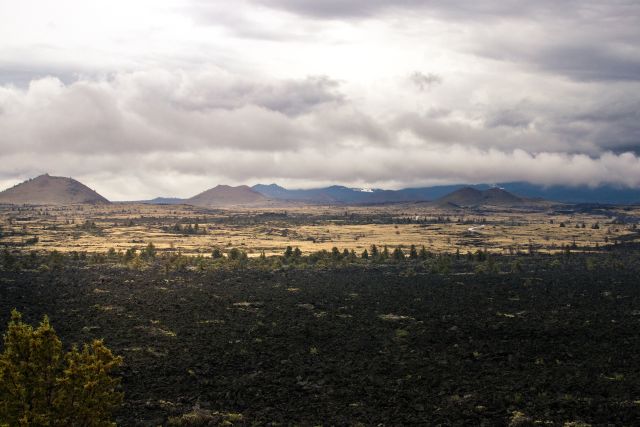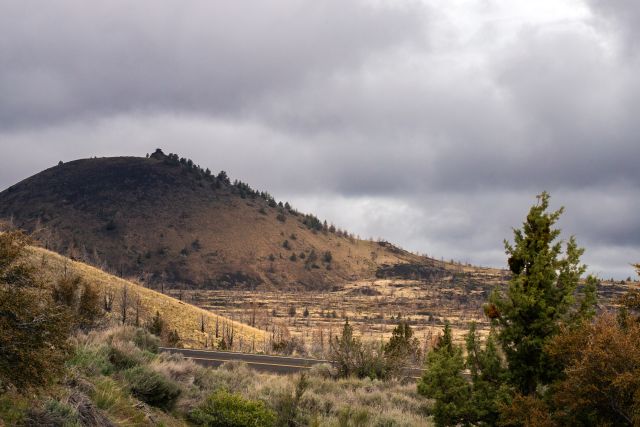History seeps through at Lava Beds National Monument
Published 4:45 pm Thursday, May 29, 2025



As I stood alone on Hospital Rock at Lava Beds National Monument, the wind whipping my hair around as the rain persisted from the west, I was struck with both a sense of awe at the sight of the land and sadness at understanding what happened on it.
The monument, located about 12 miles west of Tulelake, California, and about 20 minutes south of the Oregon border, is steeped in history, both geologic and cultural.
It is the northern flank of the Medicine Lake shield volcano (the largest volcano by volume in the Cascade range). Above the surface, it’s a vast swath of sage and grassland littered with dark volcanic rocks that spewed from the volcano, and buttes and vents that dot the landscape.
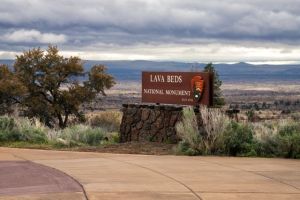
Looking north toward Gillem Bluff and the north entrance to Lava Beds National Monument. (Makenzie Whittle)
Trending
It is also a part of the ancestral homeland of the Modoc, and ultimately where the tribe faced the U.S. Army before they were removed to Oklahoma (where many still live) during the Modoc War of 1872-73.
Below the surface, the land sprawls with dozens of lava caves ripe for exploring, and above you can take in more geological wonders and also the cultural history that seeps through the land.
With the longer days of summer imminent, it’s a great time to take a day trip down to the profound and stunning national monument just across the border and wander through this stirring landscape.
The floor is lava
Coming into the National Monument from the northern side, it doesn’t take long before you see the first vast lava field, the Devil’s Homestead. Here, rough a’a lava splattered over the landscape from the nearby vents at the Fleener’s Chimneys, located about a mile south, where a short trail allows visitors to look down into these large, pyramid-like splatter cones.
The lava throughout the monument is a mix of rhyolite, basalt and obsidian, creating a varied expanse of geologic material to comb through as you explore . Remember, leave no trace; take only photos and leave only footprints.
Trending
Farther along the main road (part of the Volcanic Legacy Scenic Byway), you’ll start to see signs to various cave trailheads. All visitors who intend to enter any of the caves at Lava Beds are required to obtain a free caving permit at the visitor center, where they can be screened for white-nose syndrome and go over how to cave safely and softly with the rangers on duty.
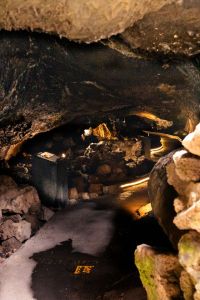
Mushpot Cave is a short, 770-foot cave that features a fully paved trail from a set of ladder-like stairs down and rope lights along the path. (Makenzie Whittle)
The visitor center also has a gift shop where you can purchase bump hats and borrow flashlights if needed, and features a small museum where you can get a better idea of the geologic, natural and cultural history of the area.
There are 24 total caves (out of more than 800) at the monument you can spelunk in of varying difficulty levels and features, but be aware of current cave closures due to wildlife protection and conditions. Visit the Lava Beds website or the visitor center for up-to-date closures.
The volcanic remnants within the monument are what is left from lava rivers that spewed from the Mammoth and Modoc craters during eruption events that took place around 30 to 40 thousand years ago. The lava cooled on the outside while the rivers of magma continued below the surface until they drained. Over the centuries, roofs collapsed, allowing humans access to the portions of the shells of these tendrils, long since cooled.
Above it all
If you are looking for more recent history, you can find that here, too, with hikes out to sites relating to the Modoc War.
The entire history and build-up to the conflict is long and includes broken promises, neglect, government ineptitude and much more and it is worth reading up on either through the Oregon Encyclopedia and the Modoc’s website or you can watch the Oregon Experience episode specifically on the Modoc Wars.
Within the Lava Beds National Monument, you can visit the key places where battles took place and where Kientpoos/Captain Jack and his band of around 60 Modoc holed up while the well-equipped U.S. Army attempted to extract and return them to the Klamath reservation, where they had been placed after they signed a treaty ceding their ancestral land so that Euro-Americans could settle in the basin.
Captain Jack’s Stronghold sits on the northern edge of the monument and features two rough-terrain loop trails (one extends further into the stronghold than the other) where you can walk among the crags, crevices and caves that the Modoc lived in and moved through during the Modoc War. I recommend purchasing the guidebook for the stronghold at the visitor center, it has great information as you walk the trail.
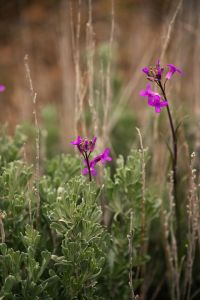
Sagebrush blooms in early May at Lava Beds National Monument. (Makenzie Whittle)
Beyond the stronghold, you can also visit places relating the U.S. Army’s side of things, including Hospital Rock, a large outcrop that was set up as a field hospital; Canby’s Cross, a large white cross that memorializes General E.R.S. Canby, who was killed during negotiations by Captain Jack (the only general to die during an Indian war); and Gillams Camp, where the Army was stationed and where the later Civilian Conservation Corps camp was set up.
You can also hike out to one of the final battlefields, the 2.2 mile out-and-back Thomas-Wright Battlefield Trail farther within the monument.
Despite the profound sadness and incredulity I felt looking over these spaces — or maybe even because of it — it’s hard not to be struck by the beauty of this land. The vastness of it, the life that surrounds it from the Lower Klamath Wildlife Refuge and the critters that crawl, slither and soar above it. I understand why people wouldn’t want to leave it.
Just across the border
With long days at hand, it’s worth the drive down to Lava Beds National Monument, even if it’s just for the day. With caves to explore, trails to take on and history to absorb, the monument is easy to get figuratively lost in. And with the neighboring wildlife refuge bordering the edge of the park, those wanting to add to their birding life lists can do that while taking in all that this vast expanse of lava fields and grasslands has to offer, a feast for the eyes and for adventure.
If You Go
Where: Lava Beds National Monument, 1 Indian Well, Tulelake, California
When: Open year-round
Cost: $25 private vehicles, $20 motorcycles, $15 bike or walking; America the Beautiful passes accepted.
Notes: Dogs are not allowed in caves, trails or the visitor center but can be walked along the paved roads on a leash. Limited cell service throughout the park. WiFi is available at the visitor center.


